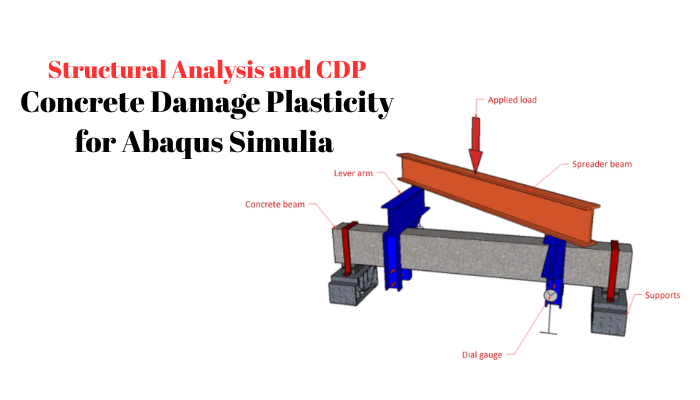
Concrete is the most prevalent construction material because of its strength and durability. But, as time goes on, concrete can start to crack, deform, and even fail at times when a certain load has been applied to it. Due to the unpredictable behaviour of concrete when stressed, engineers have the desire to have tools we can use to predict the behaviour of concrete structures and how they will respond when loads have been applied. This is where the Abaqus concrete damage plasticity model comes in. It is probably one of the best available simulation tools that can be utilized in the Abaqus suite, which will allow you to test and understand how concrete behaves under loading conditions.
In this blog, we will write about how the Abaqus concrete damage plasticity model works, how it has been applicable in a real engineering situation, and why this is a skill civil and structural engineers can benefit from having. We will also cover one of Abaqus training courses, which will enable you to learn this powerful tool for your professional career.
What is Abaqus Concrete Damage Plasticity?
Abaqus Concrete Damage Plasticity (CDP) model is an Abaqus material modeling feature that allows engineers to model the failure response of concrete. Unlike simple concrete models that how only linear elastic behavior, the concrete damage plasticity model incorporates cracking in tension, crushing in compression, plastic flow, and loss of stiffness with damagThe CDP model is specific to concrete and quasi-brittle materials, therefore this model is able to give plasticity (permanent deformation) and damage mechanics (reduction in stiffness through micro-cracking). This two-fold process makes this model ideal for complex structural modelling applications with Abaqus, such as structural analysis applications, as accuracy is important.
This model is based on experimental testing and theoretical models, where the user can evaluate the performance of concrete under different loading conditions.
Structural Concrete Applications
To demonstrate actual use of Abaqus concrete damage plasticity let's consider an example of an analysis of a reinforced concrete (RC) beam.
RC Beam Design (IS 456:2000 Based)
- Beam size: 230 mm x 300 mm x 3000 mm
- Main reinforcement: 2 bars of 12 mm dia Fe 415
- Stirrups: 8 mm dia @ 150 mm spacing
- Cover: 40 mm
- Support conditions: Hinge and roller
- Loading: Two-point loading through jacks
- Allowable deflection: 12 mm
This beam was simulated using solid elements for concrete and beam elements for the steel rebars. The embedded region method was applied to couple the two materials. The universal ABAQUS CDP model was applied to model the nonlinear aspect of the concrete while the steel was defined using a typical elastic-plastic model.
This kind of simulation configuration is usually shown in Abaqus tutorials and plays a vital role in defining how real service beams behave under loads.
Learn Abaqus Structural Analysis CDP with Our Hands-on Online Course
Want to Become an ABAQUS Concrete Damage Plasticity Modeling Wizard Using a Step-by-Step Process?
Sign Up for Our Abaqus Structural Analysis & CDP Course
Numerical vs Experimental Results: Accuracy of CDP
Here's a comparison of theoretical, simulation, and experimental results for the RC beam analysis using Abaqus Concrete Damage Plasticity:
| Beam | Rod Dia (mm) | Ast (mm²) | Theoretical Deflection (mm) | Abaqus (CDP Model) | Experimental |
| Beam 1 | 12 | 226.1 | 4.14 | 3.925 | 2.76 |
| Beam 2 | 16 | 402.1 | 4.14 | 3.743 | 2.81 |
| Beam 3 | 20 | 628.3 | 4.14 | 3.557 | 2.91 |
These results confirm that ABAQUS concrete damage plasticity gives very close and accurate results compared to physical tests, and hence it is a safe method for engineering analysis.
Advanced Example: Strengthening Using NSM Jute Reinforcement
In another test, we tested RC beams with 20 mm-thick NSM (Near Surface Mounted) jute layers used for strengthening the beams. Deflection of the beam was reduced markedly, demonstrating how effective this kind of strengthening will be.| NSM Beam | Rod Dia (mm) | Ast (mm²) | NSM Thickness | Abaqus CDP Deflection (mm) |
| NSM 1 | 12 | 226.1 | 20 mm | 3.253 |
| NSM 2 | 16 | 402.1 | 20 mm | 3.104 |
| NSM 3 | 20 | 628.3 | 20 mm | 3.012 |
This sort of analysis happens frequently in the Abaqus tutorial on masonry walls, where extra reinforcements are simulated for assessing strength as well as performance improvements.
Benefits of Learning Abaqus Concrete Damage Plasticity
- Realistic Modeling: Cracking and crushing fully with accuracy
- Widely Used: Research and consulting companies and design standards
- Versatility: Use on beams, slabs, walls, columns, and masonry walls
- Career Booster: Required for anybody doing structural analysis courses
- Greater Accuracy: Extremely close to the experimental conditions.
The ABAQUS concrete damage plasticity model is used by engineers around the world for existing bridges, dams, high-rise buildings, and for designing retrofitting. Learning how to use it exposes you to a whole new set of career and research opportunities.
Conclusion
Structural engineers need tools not just to model loads and stresses, but also can forecast and predict failure and damage. The ABAQUS concrete damage plasticity provides you with a strong method for understanding and visualizing the behavior of concrete in real conditions. Whether you are simulating R/C beams and slabs or masonry walls, CDP allows you to make better design and safety decisions.If you envision a future in civil or structural engineering, do something about today. Take our applied course and become an expert at Abaqus structural analysis using the Abaqus concrete damage plasticity model.
